Bob Cancalosi, a former General Electric executive who underwent treatment for a rare form of head and neck cancer, recently returned to Mass Eye and Ear to make his first gift: a new bell. Focus caught up with Bob, who explained how the hyperbaric oxygen treatment he received helped close “a large hole” on the side of his head.
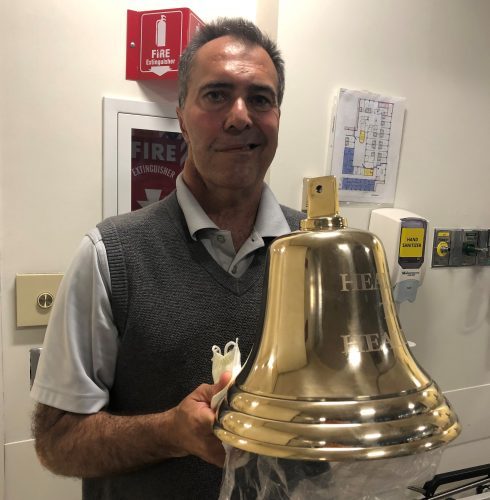
Patients inside the Norman Knight Hyperbaric Medicine Center at Mass Eye and Ear celebrate the end of their hyperbaric therapy treatment by occasionally ringing a bell hanging near the doorway. Some patients might give the bell a gentle tap. Others: a strike heard from halfway down the hall. And then, there’s Bob Cancalosi.
After completing his final round of hyperbaric therapy inside the center in December 2019, the 60-year-old from Lexington, MA, stood up from his bed, walked to the doorway, and, out of pure excitement, rang the bell so loud, it broke.
His excitement was warranted; Bob had undergone 30 rounds of hyperbaric therapy to close a large, open hole on the right side of his head. The troublesome wound had developed following a series of complicated head and neck cancer surgeries to treat a rare cancer on his facial nerve. Tissue from his arm was used to close the wound, but complications had prevented it from healing properly.
“My face had been cut open so many times and the hole just wasn’t closing,” Bob told Focus. “But, after each round of hyperbaric therapy, I watched it go from the size of a half dollar, to a quarter, to a nickel, to a dime, to absolutely nothing. It’s amazing how these hyperbaric chambers work.”
Hyperbaric science
Tissues and cells rely on oxygen to stay healthy. When blood vessels are damaged, they cannot deliver a sufficient amount of oxygen to neighboring cells and tissue, prompting healthy cells to die and preventing injured cells from recovering.
According to Adina Gutium, MD, an internal medicine physician and co-director of the Norman Knight Hyperbaric Medicine Center, hyperbaric therapy can promote wound healing by exposing patients to heightened levels of oxygen. Normally, a person breathes 21 percent oxygen from the surrounding air. During hyperbaric therapy, patients breathe 100 percent oxygen at greater than normal atmospheric pressure.
“The theory behind hyperbaric therapy is that the increase in oxygen levels can stimulate the growth of new blood vessels,” explained Dr. Gutium. “The treatment itself is well tolerated and I’ve seen numerous patients show dramatic improvements from chronic wounds.”
Hyperbaric therapy can help heal tissue following reconstructive head and neck surgery and radiation treatments. In Bob’s case, numerous rounds of radiation had damaged blood vessels surrounding his facial tumor. The lack of blood flow to tissue on the right side of his face prevented the wound on his head from healing and allowed it to expand.
“The open wound on the side of Bob’s head had not completely healed after several different methods, including leech therapy, had been attempted,” explained Theresa Johnson, MSN, RN, senior director of nursing inpatient services at Mass Eye and Ear. “His physicians then decided to employ hyperbaric therapy. Bob responded excellently to the treatment, and the entire staff was as happy as he was when the wound healed weeks into treatment.”
A state-of-the-art center for world-class care
Hyperbaric therapy is not limited to treating head and neck cancer patients. In fact, the therapy is used to treat a wide range of conditions prescribed by the Undersea & Hyperbaric Medical Society, including diabetic wounds and decompression sickness (the bends), and is most associated with treating carbon monoxide poisoning.
Inspired to save the lives of firefighters and EMS workers who regularly expose themselves to such conditions, Mr. Norman Knight, a self-made broadcast pioneer and media mogul, brought hyperbaric medicine to Mass Eye and Ear in 1995. His generous funding provided two state-of-the-art hyperbaric chambers on the 11th floor of the hospital. Today, the center is the longest-running in New England and the only kind available 24/7 for emergencies.
During treatment, patients lay inside a chamber for about two hours. The chambers circulate 100 percent concentrated oxygen and compress air to about two times the level of atmospheric pressure at sea level. This allows large amounts of oxygen to dissolve into the bloodstream and other tissue fluids.
While certain conditions might require one or two rounds of hyperbaric therapy, extensive tissue damage in patients like Bob might take up to 30, or even more, rounds of treatment.
The center currently only treats conditions approved by the Undersea & Hyperbaric Medical Society, but is also exploring opportunities for research. Dr. Gutium believes with more study, the therapy could one day treat even more conditions.
“While the pandemic has hindered our ability to conduct research over the past year, we look forward to collaborating with other hospitals within Mass General Brigham to investigate other ways hyperbaric therapy can help patients live a better quality of life,” she said.
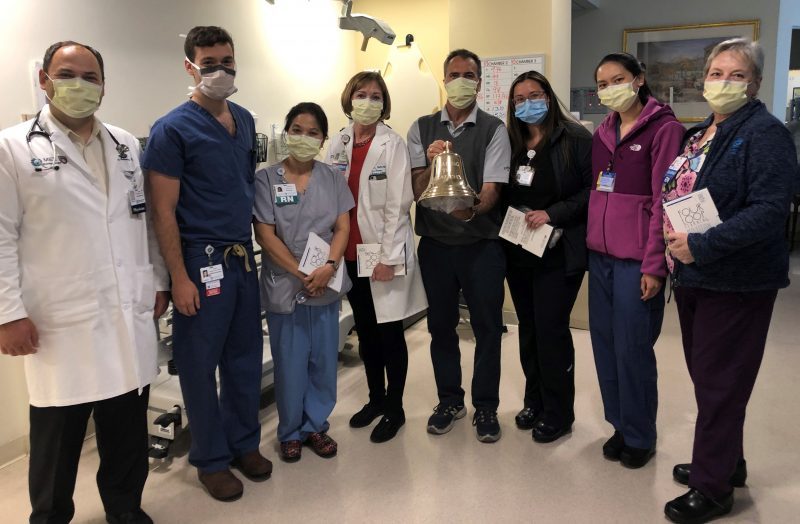
From healing to healthy
A few years after his final round of hyperbaric therapy, Bob returned to the Hyperbaric Medicine Center to present his first-ever donation to Mass Eye and Ear: a new bell.
The bell, inscribed with the mantra “From Healing to Healthy,” was his way of saying thank you to the nurses and physicians in the center who played an indispensable role in closing the wound on his head during his 21-day stay in the hospital.
After shaking hands with each staff member on the 11th floor, Bob took one last look at his gift. Thinking of all the future patients who might feel that same surge of excitement he felt years ago, he made a parting request:
“Every time you hear that bell, I want you to remember me as a very small part of a very large group of people in extreme gratitude for your expertise, your clinical skills, and your commitment to being frontline in the worse pandemic we’ve seen.”
Learn more about Bob and his Mending Crooked Smiles Fund at www.FourLoopLearning.com
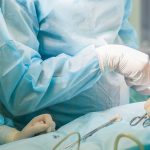
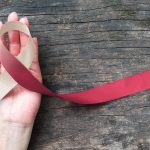
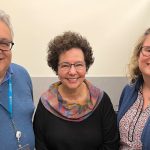
Congratulations Bob. I too had hyperbaric treatment after my care by Dr Derek Lin. That bell, as do bells rung by Budhist monks, or New England churches calls attention to the spiritual healing the 11th floor offers those of us with head and neck cancer. I join with others in celebrating the medical professionals and facility that allows us more time to love our families. Thank You!!
Bill, thanks for reading Bob’s story and your great comment. We can see you know firsthand the experience of being on the 11th floor at Mass Eye and Ear. We’ll pass along your comment to Bob.
Have You developed treatment for the debilitating effects of Lyme Disease?
Hi Maggie thanks for reading and your comment. Our center only treats conditions indicated by the Undersea & Hyperbaric Medical Society. https://www.uhms.org/resources/hbo-indications.html
It is wonderful to hear of the sucess of the hyperbaric center in healing wounds and treating carbon monoxide exposure and ‘the bends”. As someone who has followed the center since even before the generous 1995 Norman Knight gift, I especially applaud the interest in pursuing new research initiatives. A recent article in the Journal Aging claims hyperbaric therapy can have material benefits at the cellular-biological level including on brain functionality. Might this area be worth considering for future research?
Hi Gary, thanks for your comment and kind words! Our team at the HBO center is reviewing all the recent research and if the Society changes its guidance on conditions to treat, will follow those guidelines.
The blogs are really appreciable and one can trust the knowledge and information provided in the writing.